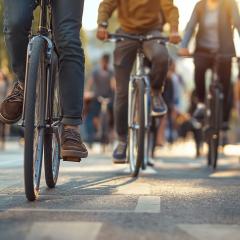Only five years ago, most people’s transport choices were limited to car, bus or train, bicycle or walking. Today, electric bikes and scooters have rocketed up the options list. And they have the potential to solve many of our commuting and environmental challenges.
Up to 130 million e-bikes are predicted to be sold worldwide between 2020 and 2023, according to the Deloitte Technology, Media, and Telecommunications Predictions 2020 report.
Front runners in adoption are the usual European crew, with Germany, the Netherlands and Spain all seeing dramatically increased e-bike sales in 2018 and 2019, the report says.
But the good news is there’s lots of Australian research being done on using e-bikes and e-scooters locally, too.
This month, UQ completed a survey on electric mobility on campus as part of its long-term infrastructure planning. We’ve been asking you to tell us if you can see yourself using an e-bike or e-scooter to get to uni? Or maybe you’d like to use one to get around campus?
Or maybe, like many people, you haven’t really thought about it before. UQ researchers Dr Jake Whitehead and Dr Dorina Pojani take us through a few common e-mobility considerations.
The first mile/last mile problem
How familiar is this scenario? You live quite near a great bus route to your place of work or study, but … just not that near. It’s 20 minutes’ walk or more to the bus stop.
By the time you add on the journey itself, it might take you an hour to get to your destination. If you drive, your total commute is about 25 minutes. Guess which option wins every time.
It turns out this conundrum is so common it has an official name: the first mile / last mile problem.
Jake says it is a phenomenon that occurs all over the world.
“The last or first mile of a journey can be the difference between someone choosing to use public transport versus driving,” he says.
“But ‘traditional’ green modes such as cycling or walking don’t always work out. Sometimes the distance is too great, your professional clothing doesn’t lend itself to exertion, or the terrain is too hilly to make self-propelled activity pleasant.”
Enter e-bikes and e-scooters. With the right infrastructure and support in place, they might just make it possible for you to ditch the car more often.
Designing holistic systems
So, what is the right infrastructure? One obvious problem you’re probably thinking about straight away is what to do with your e-bike or e-scooter when you get to your transport or end-destination.
Do you have to take it with you on the train or bus? Some transport options allow for this, but not usually during peak hour and it’s hardly a mass-scale, practical solution.
Another possibility is a sharing scheme. Brisbane City Council has had a pedal-power bicycle sharing scheme in place since 2010. In 2018, the council released data showing a 35% increase in trips taken on the previous year, crediting that growth to making sure bike stations were in relevant locations and introducing tap-and-go payment options. This reinforces the idea that when transport and mobility options are made easier, we’re more likely to use them.
In 2018, the city’s first dockless electric scooter sharing also came to town. It got off to a strong start, and a couple of companies now operate in the inner city area. While, observationally at least, there seem to be fewer scooters about than in their first Brisbane flush, they nonetheless remain a firm fixture in CBD and Fortitude Valley streets.
E-scooter sharing systems have been successfully integrated in many global cities including Berlin, Buenos Aires (which approved legislative reform in 2019 to make their use easier) and Santa Monica, California (PDF, 11.7 MB) (often referred to as the birthplace of the shared e-scooter system!).
However, designing holistic systems means thinking even more broadly, Dorina says.
“Other initiatives include building more secure parking for e-mobility at either end of the journey.
“So, not just ensuring there are spaces at major transport hubs, but also at offices, too,” she says.
With battery technology improving, e-bikes and e-scooters are also becoming more affordable.
“In the future, it may be possible to keep a device at each end of the journey,” Dorina says.
Meanwhile, infrastructure such as dedicated bicycle lanes that are continuous and segregated from vehicular traffic have been proven to increase cycling rates (electric or regular), according to a 2018 paper Why isn’t Australia a cycling mecca? by Dorina and her colleague, Elizabeth Butterworth.
“COVID has presented an opportunity that should be capitalised on, with a surge of interest in all sorts of micromobility (meaning, walking, cycling, scootering) as people seek to avoid crowded transport,” Dorina says.
“This has unfortunately meant more cars on the road, too. But are there big-picture changes cities could consider to help people choose greener options instead? For example, could we be looking to convert some car lanes to bicycle lanes?”
What about rain? What about summer?!
Another qualm that commonly surfaces is what to do when the weather doesn’t go your way.
Queensland, for example, has months of hot, humid days through December to March, often alongside unpredictable patches of tropical rain. And the scorching sun is a health concern at all times of year.
If councils are really committed to improving the infrastructure for bikes and scooters, however, these problems are not insurmountable, Dorina suggests.
Sheltered bicycle or walks ways are one solution that have been implemented with success in some global cities, she says in a joint-authored article published on The Conversation. For cooler climates, the Netherlands has also experimented with heated paths to help melt the snow.
Granted the latter is not an issue we’re likely to experience in Brisbane anytime soon, but Dorina’s main message remains around the importance of holistic thinking and the integration of policy, systems and practical changes.
“We can’t solve one part without the others,” she says. “But we can look to case studies from around the world where these kinds of investments have successfully begun to change people’s mindsets and their behaviours.”
Transport ‘packages’
At the forefront of transport and mobility research is another idea that involves bundling a variety of mobility options into a subscription ‘package’, referred to as ‘mobility as a service’ (MaaS).
The basic concept, as Jake explains, is that people take out a subscription that gives them access to a variety of transport methods. Monthly, these could include a set number of hires via bike or scooter sharing schemes, unlimited bus or train trips, maybe a couple of car loans for a weekend getaway or a grocery shop, and perhaps even a couple of taxi vouchers for the times when you get caught out late or it’s raining heavily.
“Accessibility and affordability for everyone are key,” Jake says. “It’s not fair, at the moment, that if you can’t afford to live close to campus or the city, you also have to pay more for public transport. And you’re much less likely to have access to sharing schemes and other mobility infrastructure.
“Mobility-as-a-Service aims to flip all that on its head. It’s about creating choices and designing a more equitable and thoughtful ecosystem that enables people to move around using a combination of macro and micro mobility options.”
Again, the concept has been implemented and trialled in countries around the world. Sweden, Finland and the United Kingdom are all identified as locations with early development and growth of MaaS schemes in a new book, Understanding Mobility as a Service, by professor David Hensher (founding director of the Institute of Transport and Logistics Studies at The University of Sydney) and colleagues.
Led by David, the institute completed four years of research into the impact of MaaS on future societies and conducted the first Australian trial in Sydney. The book explores key questions such as the role technology (and technology companies) will play in facilitating MaaS, how regulations and pricing might impact its rollout, and what kinds of barriers exist to mass take-up.
Give it a go!
Ultimately, though, Jake says the best first step you can take towards using an e-bike or an e-scooter is to just give one a go!
“As with all technologies, before you try it, you feel it’s a bit unknown and you’re not sure about the benefits.
“But once you experience it, and you understand how much easier it is to get around, it becomes very appealing – and fun,” he says.
Dr Carlos Fujita-Dimas, who is working on a new electric mobility plan for UQ, agrees.
“I use an electric scooter to commute to campus each day,” he says. “I travel around 8km and I find I can get most of the way on bike paths or pedestrian ways.”
“UQ is already doing lots of great work in the electric mobility space. We’ve upgraded many of our fleet vehicles to electric cars or hybrids. And several of our researchers are conducting leading research in this field.
“We’ve also noticed more and more students and staff are arriving on campus with their own e-scooters and e-bikes. So, we want to know, ‘what do you need?’. Would charging stations be useful? What about secure parking?
“The aim of our strategy will be to put all of this information together so that we can set ourselves targets, encourage sustainable behaviours, and ensure everyone feels safe and comfortable as these new devices begin to move around campus.”



